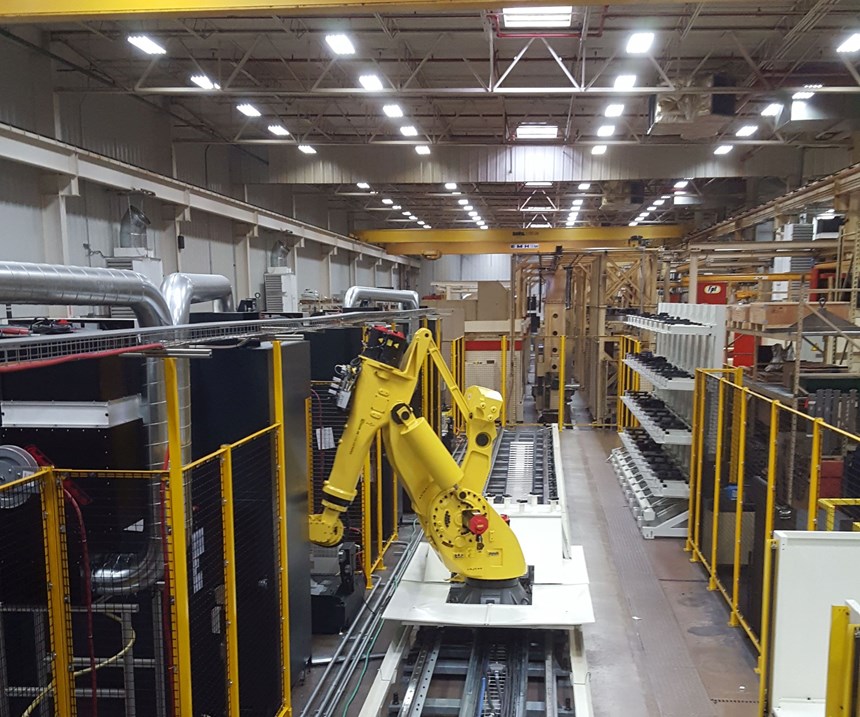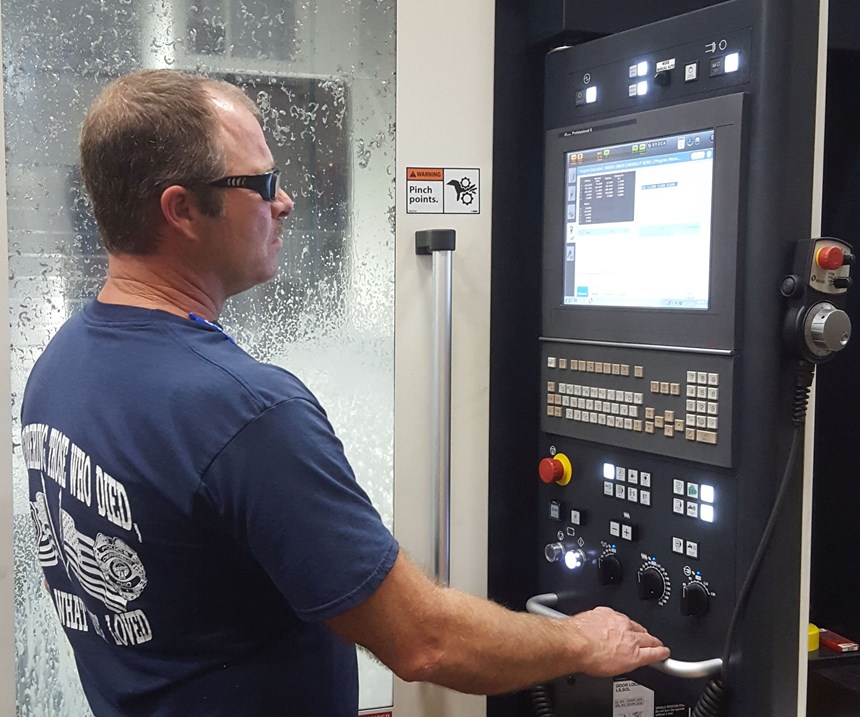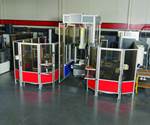CNC Machining Cell with Robot Elevates Production and Savings
Cooper Tires speeds tire-mold production with advanced CNC machining and automation technologies.
Anyone who owns a vehicle and who purchased tires for it is probably familiar with Cooper Tires, the flagship brand of parent company Cooper Tire and Rubber Co. (Findlay, Ohio). The Cooper Tires moldmaking plant is based in Findlay and currently designs and builds about 300 molds per year to produce tires for cars, minivans, SUVs/CUVs and pickup trucks.
Dan Duling is Cooper Tires’s project engineer, overseeing the company’s 24/7 moldmaking operations and its 85 employees. About two-and-a-half years ago, his plant took delivery of four new Makino D500 five-axis vertical machining centers (VMCs), a 40-position MMC2 pallet stocker and a FANUC seven-axis robot that operates on a rail system—an update to an aging CNC machining cell comprising 8 five-axis machine tools. Replacing just half of the less-efficient CNC machines with the Makino D500 machines has produced several notable benefits to the moldmaking process, Duling says, and will most likely lead to further investment in machine tools and automation sooner rather than later.
More Capability, Less Equipment and Material
Cooper Tires’s previous processes involved using a lot more CNC equipment, including a vertical turning lathe, a saw and a wire EDM machine, Duling says. Because tires are round and because the 20-year-old milling centers were not as versatile as the new Makinos, the company’s moldmaking process began with a ring of aluminum material that was turned, cut into eight segments and then machined with wire EDM to burn through the remainder of the mold details. All those steps were necessary in addition to the vertical milling that was performed on more than one of the eight machines in the cell, he says.
Today, Cooper Tires no longer uses the lathe, the saw or the wire EDM machine for upfront processing. “The advanced capability of the Makino D500 and the new robot have made it possible for us to machine the complex treads in three setups (the operator must flip the parts) and run unattended,” Duling says. “We took about 30 hours out of the processing time.” Now, the lathe is used for only one mold component—a turned part that has the brand name, inflation pressure, size of the tire and related warnings machined into it. “The EDM machine and saw are idled,” he says. “We’re looking to sell off that equipment and purchase a smaller EDM machine for other work that we are trying to bring in house.”
We have reduced our downtime by about 30 percent just by adopting automation and eliminating most of the manual processes.
Besides the reduction in equipment that the team needed to machine tire molds, Cooper Tires has reduced the aluminum it needed for the molds as well. Again, the company started with aluminum “rings” or cylinders that were cut into eight machinable segments. “That posed some problems,” Duling says. “If we had to scrap a piece out of that mold, we would have to acquire a whole new ring and cut it up just to get one extra segment, which added a lot more expense in the cost of the mold. With the Makino D500 five-axis machines and the FANUC seven-axis robot, we no longer have to purchase the material in rings. Instead, we order individual blocks of aluminum for each segment. Now, if we scrap a part, we only replace what we scrap. We don't need a complete ring, so we eliminated some processes and saved, on average, about $300 to $400 in material per mold.”
More Automation, Less Downtime
With the investment in new, advanced CNC and automation technology came the elimination or significant reduction of manual processes, Duling says. He has 16 employees who work on the shop floor. One operator tends the new Makino cell with the four new D500 VMCs and the four Fidia five-axis verticals remaining in the old cell. The company also has four FPT Stinger five-axis VMCs that are fed by parts that the Makino cell prepares. Only one operator oversees production on the company’s only milling cell, unless workloads are heavy. In that case, a second operator is put on the cell. Unavailable operators and a lack of reliable automation from the existing cell to keep jobs moving from machine to machine using its Automated Rail-Guided Vehicle (ARGV) caused much of the downtime that Cooper Tires experienced, Duling says. “The ARGV was capable of automation but was unreliable,” Duling says. “With very geometrically complex tire tread designs and CNC machines that were bordering on 20 years that were inefficient and incapable of holding the tight tolerances we demand today, an operator had to be available to load the parts into the machines, set up everything and start the programs. The operator, however, might be tending other machines, be on break or even be on vacation.”
Makino worked with Cooper Tires to write the necessary macros for probing the parts, setting up the parts and running programs for the new machines and robot. Now, when a job order is created for the CNC cell, the new FANUC robot brings fixtures to a work-set station and from there tells the operator which part needs to go on which fixtures. Once the mold segments are in place, the operator pushes a button, and the Makino Advanced System (MAS) automation takes over. MAS is the brains of the system, and it keeps the machines loaded and running whether an operator is present or not.
“The NC program is uploaded and stored in the PRO6 control, from which the MAS directs the robot to perform the tasks of loading the machines and starting the programs,” he says. “The robot doesn’t take a break, and it doesn’t need time off. It looks at the cutting tools in the machine and ensures that everything is ready and available. Based on due dates and run-time estimates that we feed into the system, the MAS prioritizes and schedules parts for machining to deliver them on time. We have reduced our downtime by about 30 percent just by adopting automation and eliminating most of the manual processes.”
The FANUC seven-axis robot gives us the freedom to move anywhere within the cell, plus the versatility to add many different types of machines while minimizing the cell footprint.
Additionally, Duling says that the machining technology is so advanced that Cooper Tires has been able to eliminate secondary manual processes. “Previously, our technicians were spending a lot of time—around six hours on average—blending out the tool marks and small gouges left by the older equipment,” he says. “Now, the surface finishes from the Makino D500 CNC machines are so fine that there is virtually no bench work or hand finishing required.”
He says that the PRO6 control, together with Makino’s SGI.5 (Super Geometric Intelligence) software and machine kinematics, enables Cooper Tires to switch between fast removal rates for roughing and more accuracy for finishing machining strategies. “Macros used to machine many of the part-specific features utilize information that is automatically pulled from our 3D modeling database,” Duling says. “These part dimensions and tolerances are then compiled and registered in the MAS. My goal with utilizing macros was to not put any additional programming burden on our CAM department, and it was a success!”
More Flexibility, Less Footprint
Flexibility and limited floor space were also major factors in going with a robotic system, according to Duling. “I knew that I wanted a robotic cell because if we wanted to add, say, a wash station or a coordinate measuring machine to this cell, we would have the flexibility to load them with a robot, whereas an automated pallet-handling system like the ARGV would limit what we could load.” He says that this is because of the difference in the number of axes that each system offers. An ARGV basically has an arm that shuttles palleted parts in and out of the machine, so there is no real articulation. Additionally, the team would need to install a transfer station between the machines and the ARGV, for which Duling says there is no room. “However, the FANUC seven-axis robot gives us the freedom to move anywhere within the cell plus the versatility to add many different types of machines while minimizing the cell footprint,” he says. “It further justified the advantage of adopting the robot.”
Duling points out that automation has made his shop more competitive with low-cost, overseas moldmakers. “Prior to automating, we were anywhere from $5,000 to $10,000 more expensive than the competition, but we have narrowed that gap and will continue to work to improve,” he says. He has been tasked with researching equipment to add to the existing cell, including items like a CNC machine with a larger work envelope.
“In the beginning, everybody on the shop floor was a skeptic when we said we were going to automate the machining process,” Duling says. “They've all had their eyes opened, and they believe in it now.”
Related Content
Ten Things You Need to Know about Circle Segment Milling
Considerations for evaluating if circle segment end mills or conical barrel cutters are right for your mold machining applications.
Read MoreFive-Axis Vertical Mill Increases Mold Shop Capacity by Reducing Setups
Zero Tolerance now processes blocks — from squaring to waterline drilling to rough and finish milling — on a single five-axis CNC mill, reducing setups and moving blocks in/out of multiple machines without sacrificing accuracy and surface finish.
Read MoreMoldmakers Deserve a Total Production Solution
Stability, spindle speed and software are essential consideration for your moldmaking machine tool.
Read MoreRead Next
Using Automated Technology to Fill the Skills Gap
Process automation is one of the fastest-growing strategies for overcoming capacity constraints in a mold shop.
Read MoreHow to Use Continuing Education to Remain Competitive in Moldmaking
Continued training helps moldmakers make tooling decisions and properly use the latest cutting tool to efficiently machine high-quality molds.
Read MoreReasons to Use Fiber Lasers for Mold Cleaning
Fiber lasers offer a simplicity, speed, control and portability, minimizing mold cleaning risks.
Read More
























